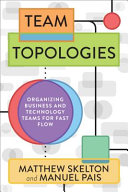

The authors introduce four fundamental team types: Enabling, Complicated Subsystem, Stream-aligned, and Platform teams. Each type is designed to fulfill specific roles within an organization, allowing for better alignment with business goals and customer needs. Stream-aligned teams are focused on a single stream of work, ensuring quick delivery and responsiveness to changes. Enabling teams help other teams to overcome obstacles and improve their capabilities. Complicated Subsystem teams handle areas of work that are complex and require specialized knowledge. Finally, Platform teams provide internal services that reduce the cognitive load on Stream-aligned teams, allowing them to focus on their core responsibilities. This categorization helps organizations structure their teams in a way that maximizes efficiency and effectiveness.
Continue readingTeam Topologies emphasizes the importance of defining interaction modes between teams: Collaboration, X-as-a-Service, and Facilitation. Collaboration is when teams work together closely on a shared goal, often leading to innovation and better problem-solving. X-as-a-Service is a more transactional relationship where one team provides a service to another, allowing for clear boundaries and accountability. Facilitation involves one team helping another to improve their capabilities without taking over their responsibilities. Understanding these interaction modes helps organizations to foster healthy relationships between teams, ensuring that they can work together effectively while maintaining their autonomy.
Continue readingThe book discusses the concept of evolutionary team structures, advocating for a flexible approach to team organization. As the needs of the business change, so should the team structures. The authors argue against rigid hierarchies and promote an adaptive model where teams can evolve based on feedback and changing circumstances. This adaptability allows organizations to respond to market changes, technological advancements, and shifts in customer expectations more effectively. By regularly assessing team performance and structure, organizations can ensure that they remain aligned with their strategic objectives.
Continue readingCognitive load is a critical concept in Team Topologies, referring to the amount of mental effort required to perform tasks. The authors emphasize the need to manage cognitive load within teams to enhance productivity and innovation. By organizing teams according to their specific types and responsibilities, organizations can minimize unnecessary cognitive load, allowing team members to focus on their primary tasks. This management of cognitive load is crucial for maintaining high performance and preventing burnout, ultimately leading to a healthier work environment.
Continue readingThe notion of a Team API (Application Programming Interface) is introduced as a way to define how teams interact with one another. Just as software components interact through APIs, teams should have clear interfaces that outline how they communicate, collaborate, and share responsibilities. This clarity reduces misunderstandings and friction between teams, leading to smoother workflows and more effective collaboration. A well-defined Team API helps ensure that teams can operate independently while still being aligned with the overall goals of the organization.
Continue readingValue Stream Mapping is a technique discussed in the book that helps organizations visualize and understand the flow of value through their teams and processes. By mapping out the value streams, organizations can identify bottlenecks, inefficiencies, and areas for improvement. This visualization aids in aligning teams with customer needs and business objectives, ensuring that every team is contributing to the overall value delivery. The authors encourage organizations to regularly revisit and update their value streams to maintain alignment and responsiveness to change.
Continue readingThe authors advocate for team autonomy as a key principle for effective team dynamics. Autonomy allows teams to make decisions, experiment, and take ownership of their work, leading to increased motivation and innovation. However, autonomy should be balanced with alignment to ensure that teams are working towards common goals. The book provides guidance on how to foster a culture of autonomy while maintaining strategic alignment, emphasizing that empowered teams are more likely to respond effectively to challenges and opportunities.
Continue reading